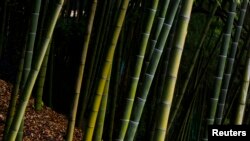Lush tracts of bamboo spread across southeastern Chipinge district, where the tall plant is increasingly regarded as green gold by villagers. They are harvesting it commercially while helping preserve Zimbabwe's fast-dwindling forests.
Bamboo is native to Zimbabwe, according to Bio-Innovation Zimbabwe, a research organization specializing in underutilized plant species. The giant grass stays green all year round, and its woody, hollow stem grows again rapidly after it is cut down.
In countries like China, bamboo has long been an industrial crop, but it is only now gaining popularity among agricultural entrepreneurs in Zimbabwe who are promoting it as an alternative to traditional timber.
For villagers like Natalia Sithole, a 27-year-old mother of three from Mount Selinda in Chipinge, growing bamboo has proved a reliable safeguard against poverty.
Sithole, who started eking out a living from bamboo at the age of 17 after having her first child, sells the plant to people around the country who use it to make products, earning her about $120 weekly.
"My life has changed for the better thanks to bamboo, and I'm managing to support even my poor parents and siblings, besides my own children," Sithole said.
The Chipinge agricultural office said about 580 women in the district were growing bamboo commercially as of early this year.
Saving forests
Just as important to some Zimbabweans are the environmental benefits. The plant is proving a boon to the country's dwindling forests, where an estimated 330,000 trees are lost annually to deforestation, much of it for commercial reasons.
Environmental experts say the rate of forest loss would be far higher were it not for the bamboo in areas like Manicaland Province. Zimbabwe's environment ministry says around 85,000 trees are saved annually through the use of bamboo as an alternative.
"Bamboo can help rural communities become less vulnerable to poverty and climate change impacts when people include the grass in sustainable forestry and agro-forestry systems," said Louise Bragge, a bamboo consultant with Bio-Innovation Zimbabwe.
Bamboo thrives in wet areas like Mount Selinda, but agriculture experts say it can also tolerate harsher conditions.
"Bamboo is drought-resistant as it has roots that grow slightly deeper, enabling it to reach out to more water underground," said Regis Mhandu, a government agricultural extension officer.
In Mount Selinda, villagers use bamboo in place of timber for a range of wood products, from household furniture and cooking utensils to toothpicks and coffins.
Many local buyers of bamboo products, like Melford Dhliwayo, say they have fallen in love with items made from the grass, and are pleased they help reduce deforestation.
"Furniture made from bamboo is quite durable even for outdoor use, unlike wood, and this means forests now are at [less risk] of being destroyed," Dhliwayo said.
Bamboo is also a handy substitute for wood in housing construction.
According to the Mount Selinda Women's Bamboo Association, a six-member group set up in 2011, approximately 600 village huts have been erected here using bamboo poles instead of wood over the past several years.
Financial returns
Environmental activists anticipate bamboo will become popular across the country because of its economic incentives.
"While bamboo is helping in the fight against deforestation, its popularity is set to grow owing to the financial returns the grass offers to growers. So as people fend off deforestation, they also make money from it," said Patience Chiri, an independent environmental activist.
The bamboo harvested from one acre of land sells for $220, much less than timber which sells for $350 per acre, according to the Mount Selinda women's group. But bamboo matures more quickly.
Erinus Ngadziore, a bamboo producer in Chipinge, says it is far less labor-intensive to cultivate than replanting trees after they have been felled.
"The bamboo also grows faster than normal trees, reaching full growth in two to three months, meaning early returns for us," he added.
Some tobacco growers have started using bamboo to cure the golden leaf. According to statistics for 2015 from the Tobacco Industry and Marketing Board, around 9 percent of Zimbabwe's 72,000 tobacco growers now use bamboo to cure their crop.
The shift appeals to tobacco farmers such as Munyaradzi Ngorima from Manicaland Province.
"The days of going all out in search of firewood to cure tobacco could soon be over," Ngorima said.







